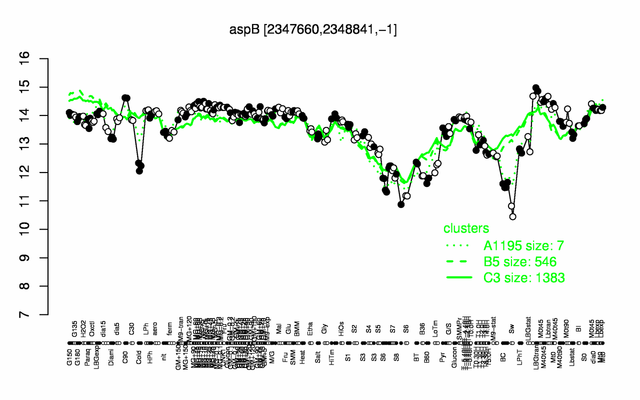AspB
Revision as of 14:03, 17 April 2014 by 134.76.70.252 (talk)
- Description: aspartate transaminase
| Gene name | aspB |
| Synonyms | |
| Essential | no |
| Product | aspartate transaminase |
| Function | biosynthesis of aspartate |
| Gene expression levels in SubtiExpress: aspB | |
| Metabolic function and regulation of this protein in SubtiPathways: aspB | |
| MW, pI | 42 kDa, 5.298 |
| Gene length, protein length | 1179 bp, 393 aa |
| Immediate neighbours | asnS, ypmB |
| Sequences | Protein DNA DNA_with_flanks |
Genetic context 
This image was kindly provided by SubtiList
| |
Expression at a glance PubMed
| |
Contents
Categories containing this gene/protein
biosynthesis/ acquisition of amino acids, most abundant proteins
This gene is a member of the following regulons
The gene
Basic information
- Locus tag: BSU22370
Phenotypes of a mutant
Database entries
- BsubCyc: BSU22370
- DBTBS entry: no entry
- SubtiList entry: [1]
Additional information
The protein
Basic information/ Evolution
- Catalyzed reaction/ biological activity: L-aspartate + 2-oxoglutarate = oxaloacetate + L-glutamate (according to Swiss-Prot)
- Protein family: TCR/tet family (according to Swiss-Prot)
- Paralogous protein(s):
Extended information on the protein
- Kinetic information:
- Modification:
- Effectors of protein activity:
- Localization: cytoplasm (according to Swiss-Prot)
Database entries
- BsubCyc: BSU22370
- Structure: 1J32 (from Phormidium lapideum, 45% identity, 66% similarity)
- UniProt: P53001
- KEGG entry: [2]
- E.C. number: 2.6.1.1
Additional information
Expression and regulation
- Regulation: constitutive
- Regulatory mechanism:
- Additional information:
- belongs to the 100 most abundant proteins PubMed
- number of protein molecules per cell (minimal medium with glucose and ammonium): 10916 PubMed
- number of protein molecules per cell (complex medium with amino acids, without glucose): 13715 PubMed
- number of protein molecules per cell (minimal medium with glucose and ammonium, early stationary phase after glucose exhaustion): 2849 PubMed
- number of protein molecules per cell (minimal medium with glucose and ammonium, late stationary phase after glucose exhaustion): 3270 PubMed
- number of protein molecules per cell (minimal medium with glucose and ammonium, exponential phase): 7546 PubMed
- number of protein molecules per cell (minimal medium with glucose and ammonium, early stationary phase after glucose exhaustion): 2849 PubMed
- number of protein molecules per cell (minimal medium with glucose and ammonium, late stationary phase after glucose exhaustion): 3270 PubMed
Biological materials
- Mutant:
- Expression vector:
- lacZ fusion:
- GFP fusion:
- two-hybrid system:
- Antibody:
Labs working on this gene/protein
Your additional remarks
References
Christine Eymann, Annette Dreisbach, Dirk Albrecht, Jörg Bernhardt, Dörte Becher, Sandy Gentner, Le Thi Tam, Knut Büttner, Gerrit Buurman, Christian Scharf, Simone Venz, Uwe Völker, Michael Hecker
A comprehensive proteome map of growing Bacillus subtilis cells.
Proteomics: 2004, 4(10);2849-76
[PubMed:15378759]
[WorldCat.org]
[DOI]
(P p)